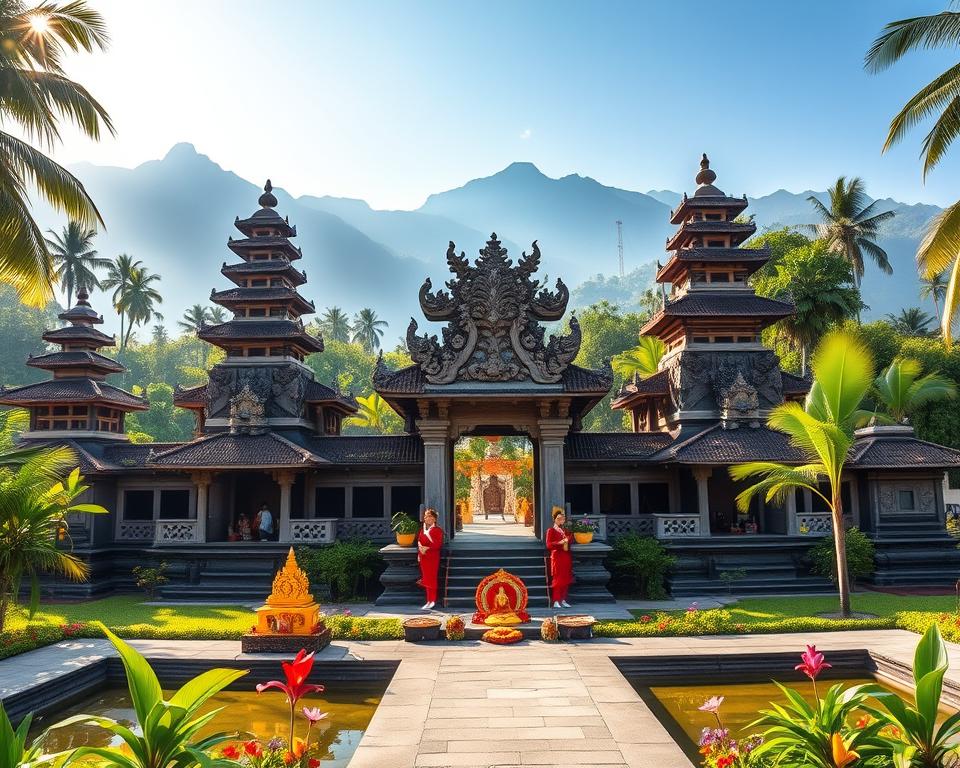
Role of Temples in Balinese Hinduism
Bali has thousands of temples called puras. They are spiritual places for the Balinese Hindu people1. These temples are key to Balinese life, showing the mix of Indian and local beliefs.
The temples’ stone carvings and green settings show the deep importance of spirituality in Balinese culture.
Key Takeaways
- Bali is home to thousands of Hindu temples called puras that serve as spiritual sanctuaries.
- Balinese Hindu priests, known as Pedanda and Pemangku, are responsible for conducting rituals and maintaining temple sanctity.
- Regular temple ceremonies, known as odalan, are a central part of Balinese Hindu life.
- Balinese temples reflect the blend of Indian influences and local beliefs in the island’s unique culture.
- Temples are vital to the preservation of Balinese Hindu traditions and customs.
Origins and Evolution of Balinese Hinduism
Indian merchants brought Hinduism to Indonesia a long time ago2. In Bali, it mixed with local beliefs. This created a special kind of Hinduism that honors nature and ancestors3.
Over time, Balinese Hinduism has changed but kept its core values3. The Majapahit conquest in 1343 was a big change. It brought new influences from Java3.
Indian Influences and Blending with Local Beliefs
Indian roots are seen in Bali’s culture and religion3. This includes temples, art, and performances. It shows how the faith has stayed connected to its past3.
Rituals and ceremonies are key in Balinese Hinduism3. They help people connect with the divine. Art, like dance and music, also plays a big role3.
Today2, 87% of Balinese people are Hindu2. This makes them a big part of Indonesia’s Hindu community2. Bali has over 20,000 temples, each with its own purpose2. In 1959, Balinese Hinduism was recognized as an official faith in Indonesia2.
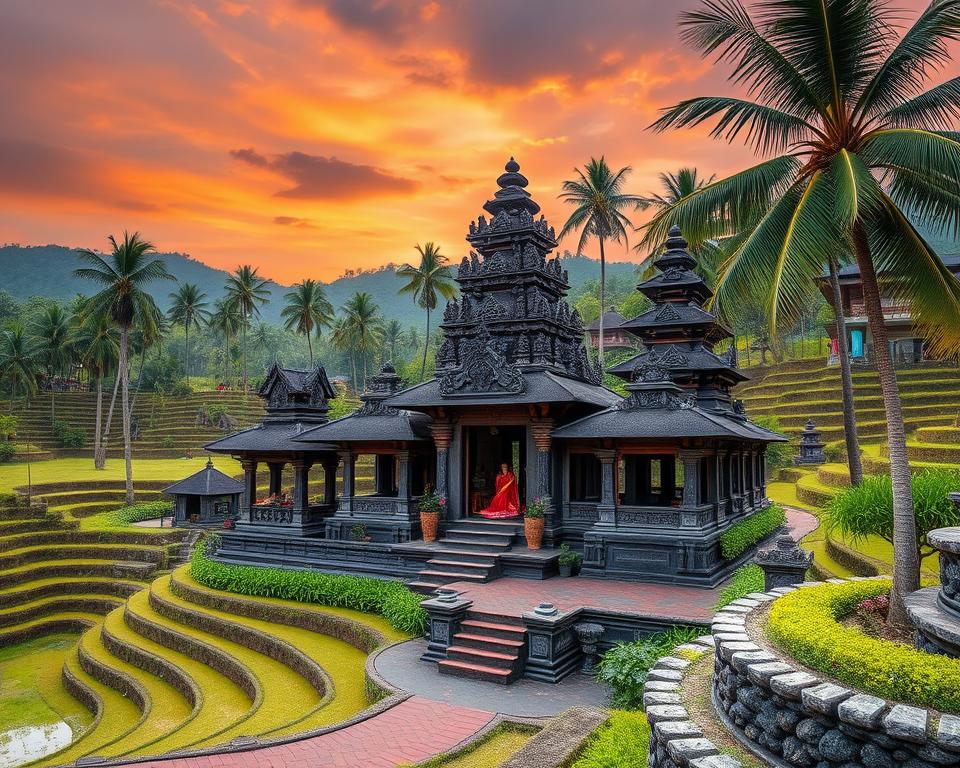
The Essence of Balinese Hinduism
At the heart of Balinese Hinduism is a deep love for nature. They believe all living things are connected4. The Balinese see the world as a balance between light and dark, good and bad, living together4.
This idea of duality is very important to them. They try to find peace and balance in every part of their lives.
Reverence for Nature and Interconnectedness
The Balinese know that light and shadow are both important4. They accept this idea and try to live in harmony with nature5. This is shown in the many temples and offerings across Bali.
They believe in one God, but also in their own traditions4. This mix of beliefs makes their spirituality strong and colorful.
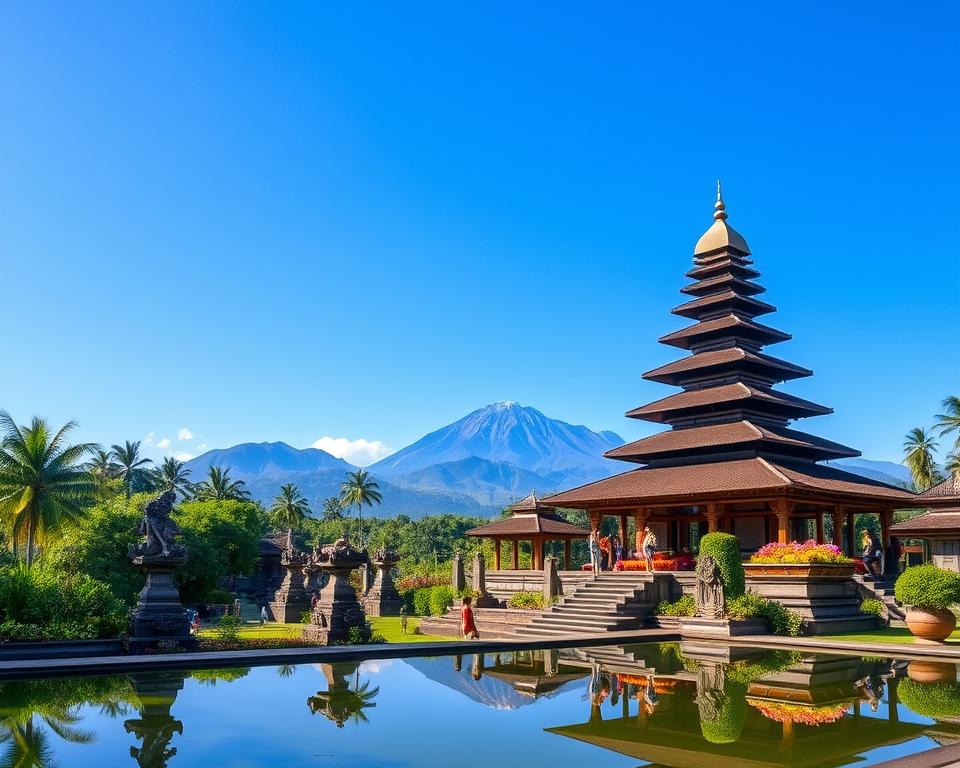
At the heart of Balinese Hinduism is the idea that we are all connected5. They aim to live in harmony with nature. They believe their actions affect the world around them4.
This love for nature and connection is what makes Balinese Hinduism special. It guides how they live and believe spiritually.
Deities in Balinese Hinduism
Balinese Hinduism has many gods and goddesses. Each one shows a different part of nature and the divine6. At the center is Sang Hyang Widhi Wasa, the top god. Along with him are the Trimurti – Brahma, Vishnu, and Shiva6.
These three gods are key. They stand for creation, keeping things the same, and ending things6.
Balinese Hinduism also has many other gods. There’s Garuda, a bird linked to Dewa Vishnu6. Dewi Sri is the goddess of the earth and rice6. Saraswati is the goddess of knowledge and arts6.
The people show their love for these gods with special offerings. These are called Canang sari. They use fruits, flowers, and symbols6.
These offerings are made in temples and on streets. They help keep peace with the world6.
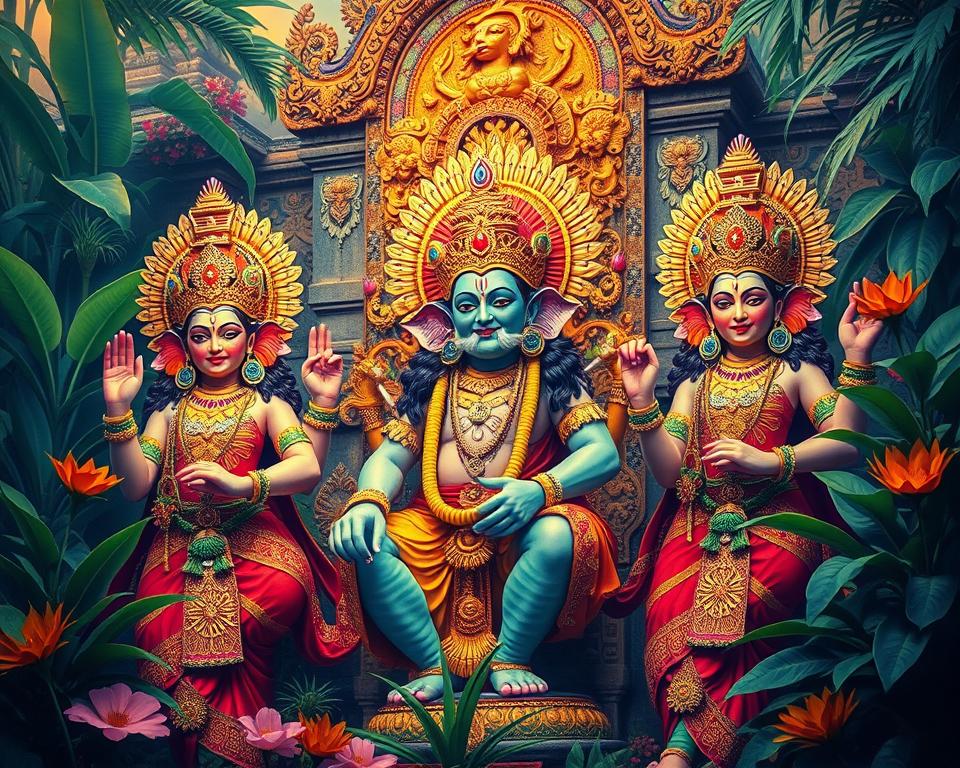
The Balinese believe the divine is all around us. They see it in these gods6. Bali is full of temples and special places for these gods6.
| Deity | Significance | Primary Temple |
|---|---|---|
| Dewa Brahma | God of Creation | Pura Desa |
| Dewa Vishnu | Preserver of Life | Pura Puseh |
| Dewa Shiva | Destroyer and Renewer of Creation | Pura Dalem |
The Balinese worship to keep balance between the world and the spirit6. Their beliefs and practices show the deep richness of Balinese Hinduism6.
Role of Temples in Balinese Hinduism
Sacred Spaces and Architectural Significance
Balinese Hindu temples, called puras, are more than worship places. They are sacred spots that are the heart of the island’s spirit7. These structures, inspired by Indian designs, show the Balinese people’s deep respect for the divine7.
They sit in green landscapes, making a calm place for people to feel close to the divine.
The temples’ design is based on the trimandala concept. It divides the temple into three parts: inner, middle, and outer7. This shows the Balinese belief in the connection between the physical, spiritual, and natural worlds7.
The candi bentar and kori agung gates are key parts of the temple’s design7. Each has its own role in the temple’s sacred layout7.
Balinese temples are more than buildings. They are alive with the island’s culture and beliefs8. From the detailed carvings to the alignment with Mount Agung, every part has deep meaning9.
These spaces connect the physical world to the divine. They offer a deep and changing spiritual experience to those who visit.
“Balinese temples are not merely structures; they are living, breathing embodiments of the island’s rich cultural heritage and spiritual beliefs.”
Rituals and Ceremonies
Balinese Hinduism is famous for its colorful ceremonies all year10. These range from daily home rituals to big village festivals. People celebrate life’s big moments like birth, coming of age, marriage, and death with special rituals10.
These ceremonies have vibrant processions, dances, and offerings. They show the Balinese’s deep devotion. It’s a sight to see.
Colorful Festivals and Life Events
The Balinese year has 250 days filled with festivals and celebrations10. They have the Nyepi day of silence and the Ogoh-Ogoh parade with giant demons. These show the rich culture of Bali10.
They also have ceremonies for life events like tooth-filing and cremation. These bring people together to celebrate important moments11.
The Balinese make daily offerings of food as a way to show thanks10. You can see these offerings everywhere, showing their philosophy of Tri Hita Karana, or the “Three Causes of Goodness”10.
| Balinese Hindu Festivals and Ceremonies | Description |
|---|---|
| Nyepi | A day of silence and meditation, marking the Balinese New Year |
| Ogoh-Ogoh Parade | A vibrant procession of giant demonic effigies to ward off evil spirits |
| Mepandes | A tooth-filing ceremony marking the onset of puberty and adulthood |
| Ngaben | Cremation ceremonies held every 5 years to send off the deceased |
| Melasti | Annual ritual cleansing ceremonies held near beaches, rivers, and lakes |
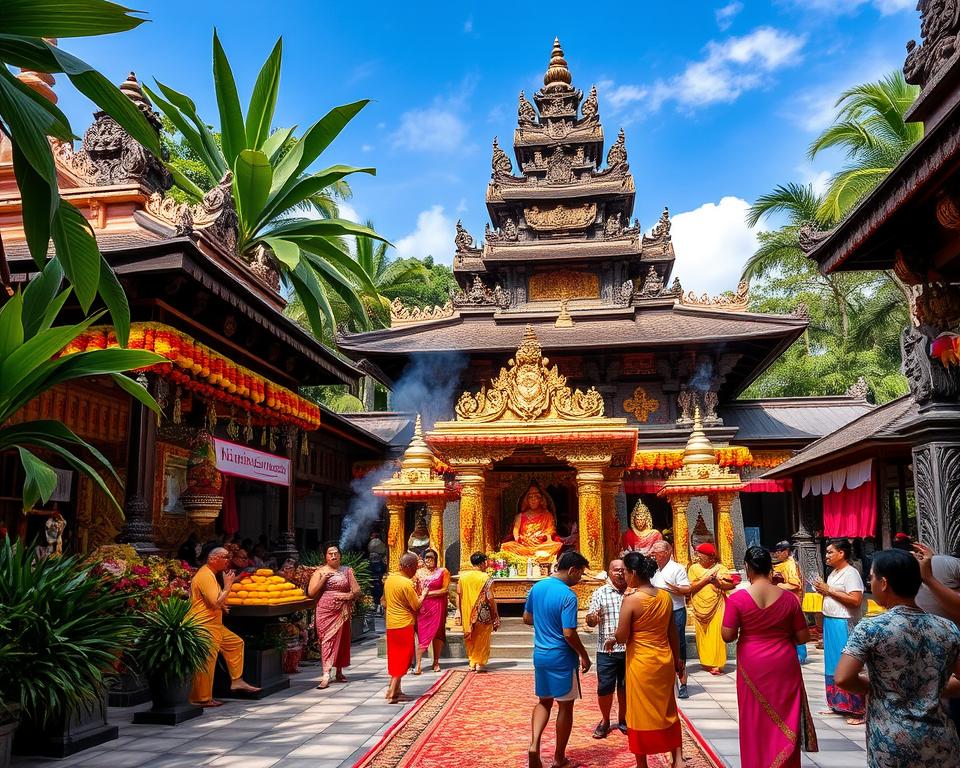
Bali is the only Hindu island in Indonesia, and its culture is rich10. There are over 20,000 temples, showing the people’s strong spiritual bond10. These rituals are a big part of their life.
“The Balinese way of life is a continuous cycle of ceremonies, rituals, and celebrations that connect the people to their beliefs, their land, and their community.”
Importance of Holy Water
In Balinese Hinduism, holy water is very important. It’s called ‘tirta’. This water is key in their spiritual practices and ceremonies12.
Holy water is believed to have spiritual power. It’s used for purification and blessings12. The word ‘tirta’ means water in Medium Balinese. Its power and uses depend on the mantras used, the source, and who makes it13.
Balinese Hindu priests, called Pedanda, make holy water13. They do rituals, chant mantras, and add flower petals to the water. This gives it divine energy12. Lay priests called Pemangku also make holy water for their temples13.
Holy water is used in many ceremonies and rituals12. It’s found in homes and temples. It cleanses and blesses people12. The water’s purity depends on its source, the mantra, and who makes it12.
The Tirta Empul Temple is famous in Bali. It was built in 926 A.D. and is visited by many, including former US President Barack Obama14. People go there to purify themselves under 30 water spouts14.
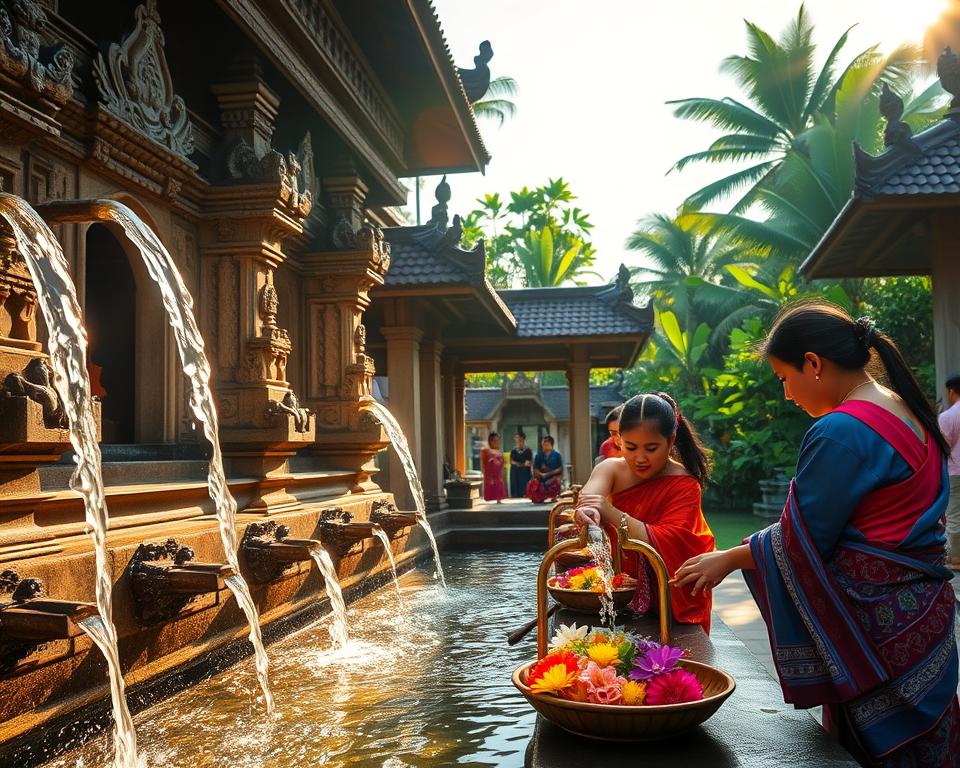
Holy water is very important in Balinese Hinduism. It connects the physical and spiritual worlds. The rituals and daily use of tirta show its deep role in their lives12.
| Holy Water in Balinese Hinduism | Key Facts |
|---|---|
| Tirta Empul Temple | |
| Types of Holy Water | |
| Obtaining Holy Water |
Holy water is very important in Balinese Hinduism. It’s a key part of their lives. It cleanses, blesses, and connects them to the divine. From the rituals of the Pedanda to daily use in ceremonies, holy water is essential.
Balinese Hindu Priests and Holy Figures
Balinese Hinduism is a mix of old traditions and spiritual ways. Balinese Hindu priests are key figures, keeping this faith alive. They are known as Pedanda and Pemangku, leading rituals and ceremonies in many temples15.
The Pedanda are from the highest caste and are the top priests. They make the “tirta” or holy water needed for many religious events16. Female Pedanda, or Ratu Pedanda, are rare but very respected in this male world16.
The Pemangku are temple priests, doing daily rituals and ceremonies. Other figures like Balian, Rsi, and Dukun also have important roles. They each bring their own special knowledge and skills15.
Balinese Hinduism is closely tied to Bali’s land and water. Water is key in its rituals and ceremonies. The Pura Tirta Empul temple is famous for its healing spring water15.
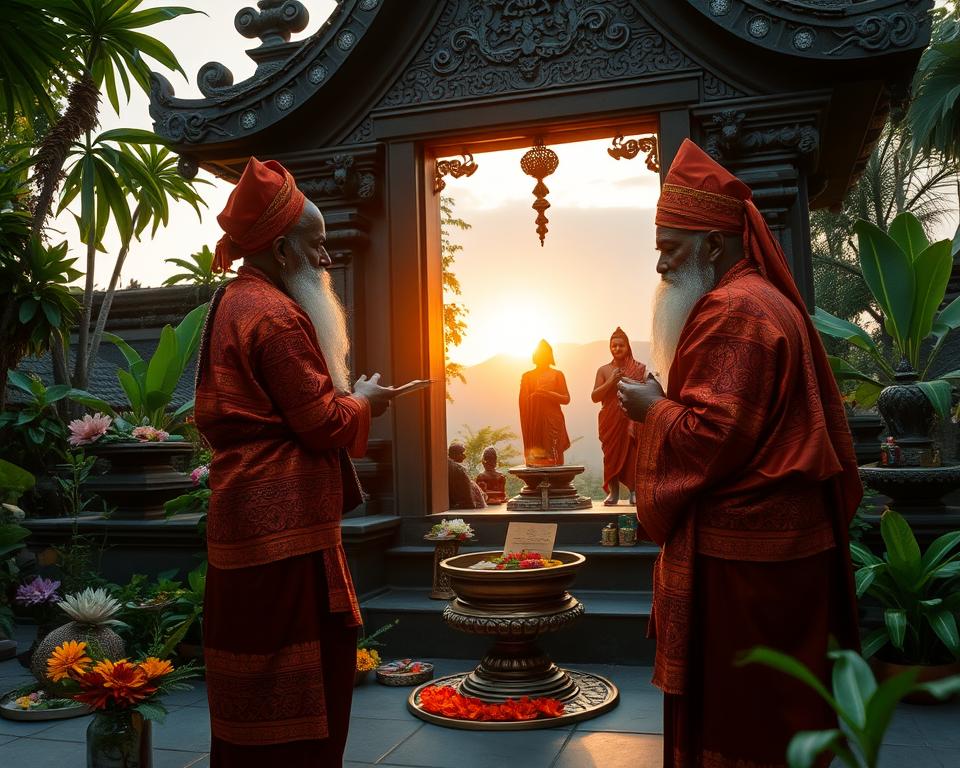
The Pedanda and Pemangku keep Balinese Hinduism alive. They help keep the island’s culture and spirituality strong. They make sure this ancient faith stays alive today16.
Caste and Clan System in Bali
In Bali, the caste system is very important, even though the government says it’s banned17. People often ask about your caste when they meet you. This helps them know how to act and show respect17.
The caste system in Bali started before Hinduism came. It’s based on what people do and their social role. There are four main castes: Sudra, Wesya, Ksatriya, and Brahmana17. The clan system also looks at family history and caste, making things even more complex17.
Even though the government wants to change things, caste is very strong in Bali. People usually hang out with those from their own caste17. This caste system affects many parts of life, like who you marry and what rituals you do17.
Each caste has its own jobs and duties. For example, Brahmanas are often chosen for special tasks in ceremonies because they’re experts17. The Balinese language also helps decide how people interact based on caste18.
The caste system in Bali is similar to India’s but is less strict18. There are talks about changing it to make things more equal. This shows how the system is always changing17.
Learning about Bali’s caste and clan system is very deep. It’s a big part of Balinese life17. As Bali moves forward, its caste and clan system will keep being interesting to learn about18.

“The caste system in Bali is a complex web of social dynamics, reflecting the island’s rich cultural heritage and its ongoing evolution.”
Types of Balinese Temples
Bali is a magical island in Indonesia. It has many spiritual places called puras. These temples are the heart of Balinese Hinduism, each with its own purpose and beauty19.
Most puras are in Bali, where Hinduism is the main religion19. Bali is called “the Island of a Thousand Puras” because of its many temples19.
Pura Kahyangan Jagad, Pura Tirta, and More
The Pura Kahyangan Jagad temples are special. They are nine temples at key points, including one in the middle19. Pura Tirta, or “water temples,” are important for the Balinese irrigation system19.
Pura Desa temples are for worshiping Brahma and other gods20. Pura Puseh temples are for Vishnu worship. Pura Dalem temples are for Shiva and Durga worship. Pura Segara temples are by the sea to honor sea gods20.
Temple design follows the trimandala concept. It has three zones: Nista mandala, Madya mandala, and Utama mandala19. The temples have beautiful gates like the candi bentar and paduraksa19.
The Balinese people love their temples a lot. They take great care of them. These places are the heart of Balinese life, showing the island’s rich culture21.
Nine Directional Temples
The nine directional temples, known as the Pura Kahyangan Jagat, are the holiest places of worship on the island of Bali22. These temples mark the eight cardinal directions, with the ninth representing the center point. They are strategically placed to protect the island and its people from evil spirits23.
Among these nine temples, you’ll find the revered Pura Besakih, the “mother temple” of Bali. Other significant landmarks include Pura Lempuyang Luhur, Pura Goa Lawah, Pura Luhur Andakasa, Pura Luhur Uluwatu, Pura Luhur Batukaru, Pura Pucak Mangu, Pura Ulun Danu Batur, and Pura Pusering Jagat23.
- Pura Besakih, the “mother temple” of Bali, is situated 900 meters up Mount Agung and features 22 temples24.
- Pura Ulun Danu Batur, dedicated to the Lake Goddess, is considered the second most important temple in Bali23.
- Pura Luhur Uluwatu, a sea temple established in the 16th century, features an entrance fee of 1,000 Rp for parking and 3,000 Rp per person, including sash rental24.
These nine directional temples belong to every Balinese on the island. They serve as the nine holiest places of worship. Each temple has its own unique significance and architectural splendor23.
“The nine directional temples in Bali, known as Kahyangan Jagat, include significant landmarks like Pura Besakih, Pura Lempuyang, and Pura Uluwatu.”23
Balinese temple complexes have three courtyards. They represent different cosmological levels: the human world (kelod), the realm of gods, and the divine level (kaja)22. The nine directional temples are an integral part of this spiritual landscape. They serve as the guardians and protectors of the island and its people23.
Six Sanctuaries of the World
Bali is a paradise with many spiritual traditions. Temples are the heart of the Balinese Hindu community. The “six sanctuaries of the world” (Sad Kahyangan Jagad) are key points in Bali, believed to bring spiritual balance25.
Pura Besakih, known as the “mother temple,” is the biggest and most important temple in Bali25. Other famous temples include Pura Lempuyang Luhur, Pura Goa Lawah, Pura Luhur Uluwatu, Pura Luhur Batukaru, and Pura Rambut Siwi26. These temples are the most sacred places for Balinese Hindu devotees, keeping Bali’s culture and spirituality alive.
- Pura Besakih, the “mother temple,” has 23 shrines and is the largest temple in Bali25.
- Pura Lempuyang Luhur is one of the “Sad Kahyangan Jagad” or “six sanctuaries of the world.”26
- Pura Goa Lawah, known as the “Bat Cave Temple,” is a sacred site within the Sad Kahyangan Jagad25.
- Pura Luhur Uluwatu, on a rugged cliff, offers a peaceful spiritual experience25.
- Pura Luhur Batukaru and Pura Pusering Jagat are lesser-known yet significant temples in Bali’s sacred landscape25.
- Pura Rambut Siwi, near the western coast, is famous for its stunning natural setting and ancient spiritual significance25.
These six sanctuaries, along with many other temples, protect Bali’s rich culture and spirituality. They offer visitors a deep journey into Balinese Hinduism25.
| Temple | Significance | Interesting Facts |
|---|---|---|
| Pura Lempuyang | One of the “Sad Kahyangan Jagad” or “six sanctuaries of the world” |
|
| Pura Besakih | The “mother temple” of Bali |
|
| Pura Goa Lawah | One of the “Sad Kahyangan Jagad” or “six sanctuaries of the world” |
|
Visiting these six sanctuaries and other temples in Bali is a deep dive into Balinese Hinduism25. From Pura Besakih’s grandeur to Pura Luhur Batukaru’s serenity, each temple has its own spiritual meaning. They invite visitors to connect with Bali’s traditions and beliefs25.
“Bali’s temples serve as custodians of the island’s cultural and spiritual heritage, providing peace and reflection to visitors.”25
Whether you’re a devout follower or just curious, Bali’s temples offer a glimpse into Balinese Hinduism. They invite you to dive into the island’s spiritual essence25.
Conclusion
On this journey, you learned about temples in Balinese Hinduism27. They are a big part of the island’s culture and spirit. The buildings28 and the lively rituals27 show how important spirituality is here.
Bali is home to many Indonesian Hindus27. It’s the only Hindu-majority place29 in Indonesia. With over 20,000 temples2729, it’s a special place for visitors to see.
Thinking about your temple visit, remember the Balinese people care a lot about their heritage29. They keep their traditions and temples alive27. This shows their Hinduism is strong and touches many hearts.
FAQ
What is the role of temples in Balinese Hinduism?
In Bali, temples are very important. They are called puras. People go there to pray and celebrate.
How did Balinese Hinduism evolve from its Indian origins?
In Bali, Hinduism mixed with local beliefs. This made a special kind of Hinduism. It includes nature and respect for ancestors.
What is the essence of Balinese Hinduism?
Balinese Hinduism loves nature and believes in connection. It sees good and bad as part of life.
What are the key deities in Balinese Hinduism?
Important gods include Sang Hyang Widhi Wasa and the Trimurti. There’s also Dewi Sri and Saraswati.
How are Balinese temples designed and what is their architectural significance?
Balinese temples look like Indian ones. They have carved stones and tall gates. The design follows a special layout.
What are the key rituals and ceremonies in Balinese Hinduism?
Bali has many colorful ceremonies. They happen all year. People dance, make offerings, and say prayers.
What is the significance of holy water in Balinese Hinduism?
Holy water is very special. It’s used for cleaning and blessings. Priests make and use it in rituals.
Who are the key holy figures in Balinese Hinduism?
Priests and other holy people lead rituals. They keep temples sacred. They play big roles in Balinese Hinduism.
How does the caste system influence Balinese society?
The caste system is important in Bali. People ask about caste when they meet. It affects how they interact.
What are the different types of Balinese temples?
Bali has many temple types. There are temples for water, Brahma, and the sea. Each has its own purpose.
What are the nine directional temples of Bali?
Bali has nine main temples. They are at the eight directions and the center. Pura Besakih is the biggest.
What are the six sanctuaries of the world in Balinese Hinduism?
Bali has six very important temples. They are key points on the island. Pura Besakih is one of them.
Source Links
- https://baligram.me/blog/balinese-hinduism-introduction-for-visitors
- https://bali.com/bali/travel-guide/culture/balinese-hinduism/
- https://www.onayaresorts.com/posts/2024/08/hinduism-in-bali-how-bali-became-hindu-2/
- https://goldcoasthindu.wordpress.com/2020/01/05/summary-of-balinese-hinduism-a-personal-perspective/
- https://www.oceanearthtravels.com/bali/balinese-hinduism/
- https://kupubarongubud.com/guide/balinese-culture-religion-gods-and-top-6-most-important-ceremonies/
- https://medium.com/illumination-curated/temple-trails-abroad-my-journey-through-balinese-hinduism-029de5544a42
- https://balipedia.com/balinese-hinduism/
- https://www.ramana-maharshi.org/the-sacred-deities-of-bali-and-their-role-in-hindu-worship/
- https://www.viceroybali.com/en/blog/bali-activities/balinese-culture/
- https://www.lotusbungalows.com/news/a-quick-guide-to-some-common-balinese-ceremonies/
- https://bali.com/bali/travel-guide/culture/holy-water/
- https://baligram.me/blog/holy-water-balinese-religion
- https://www.indonesia.travel/gb/en/destinations/bali-nusa-tenggara/bali/the-holy-springs-of-tirta-empul.html
- https://world-faiths.com/hinduism/location/bali/
- https://whatsnewindonesia.com/bali/feature/education/understanding-role-pedanda-high-priests-balinese-hindu
- https://baligram.me/blog/the-fascinating-caste-and-clan-system-in-balinese-religion
- https://finnsbeachclub.com/guides/caste-system-bali/
- https://en.wikipedia.org/wiki/Balinese_temple
- https://bali.com/temples-pura/
- https://sailingstonetravel.com/an-introduction-to-balinese-temples/
- https://www.ubudvillasrental.com/balinese-temples-6-things-you-must-know/
- https://greenerbali.com/temples-in-bali-explained-the-guide-for-beginners/
- https://www.ultimatebali.com/inspiration/must-see-temples-in-bali/
- https://blog.kura2bus.com/mystical-sanctuaries-the-ancient-temples-of-bali/
- https://baligram.me/blog/pura-lempuyang-one-of-the-six-sanctuaries-of-the-world
- https://www.thecollector.com/hinduism-bali-things-to-know/
- https://www.ramana-maharshi.org/architectural-wonders-hindu-temples-in-bali/
- https://thingstodoinkutabali.com/balinese-hinduism-and-temples/